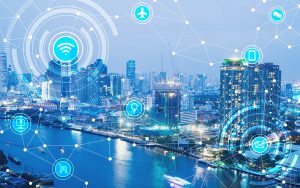Metropolitan areas are driving the rise of intelligent city infrastructure

What is a Smart City?
A smart city is an urban development concept that integrates information and communication technology (ICT), sensors, the Internet of Things (IoT) and big data to provide city infrastructure that can communicate with – and improve the efficiency of – intelligent objects, such as vehicles, and assets, including the information systems of transportation systems, public offices (hospitals, power plants, networks, etc.) and other community services.
Smart Urban Development
The European Union has developed a strategy for promoting smart urban growth for its metropolitan areas as part of its Digital Agenda. The EU is currently implementing smart city technology projects in Amsterdam, Barcelona, Madrid and Stockholm. The most advanced cities in terms of sensor technology applications include: Barcelona, London, Madrid, Oslo and Stockholm, in Europe, and New York, San Francisco and Singapore, further afield.
Globally, it is estimated that the global market for smart urban services will reach a staggering $400 billion per year by 2020, according to the Unacast Proximity Report.
Global Smart Cities
The report, which analyses the fifty smartest global cities in the fourth trimester of 2016, bases its findings on the use of proximity sensors, the type of sensor used, for example, to determine whether a parking place is free or to monitor the flow of traffic.
According to the report, there currently are 13,074,000 sensors installed in these cities, subdivided as follows: beacon sensors (61%), NFC sensors (16%) and Wi-Fi hotspots (22%), an 11% increase over the previous trimester. Moreover, between 2014 and 2016, the market for smart city technology increased from 8.8 to 12.1 billion euro.
The technologically advanced city-state of Singapore boasts a large number of video cameras and sensors used to analyse traffic congestion and crowd density, which provide data that can be used by the government to improve public transport, especially at peak travel times.
Barcelona has installed LED lighting that reduces power consumption and sensors to regulate irrigation based on real-time weather reports to reduce water waste.
New York has started implementing a city-wide high-speed broadband system that will be completed by 2025 and that will allow the city to monitor data ranging from air quality to traffic congestion and energy consumption.
Similarly, the London Council is monitoring traffic congestion and parking availability and has provided this data to start-ups to catalyse the development of new systems.
San Francisco has created smart parking systems that provide incentives to frequent users.
The Future of Smart Cities
However, the potential and scope of smart city infrastructure is far greater and will truly revolutionise cities around the world.
As we stand on the verge of a future dominated by artificial intelligence platforms and universally networked devices, in which self-driving vehicles exchange information with smart city infrastructure and a myriad other systems and facilities are interconnected by the Internet of Things, projects are being developed to help visually-impaired citizens use public transport autonomously, provide real-time information and emergency alerts to all citizens, and improve quality of life in myriad ways.
Indeed, the applications in this field are virtually limitless. The rise of big data, ubiquitous connectivity and sentient devices based on artificial intelligence will revolutionise just about every area of human activity and interest. And very soon these pioneering efforts in smart urban development will be dwarfed by the services that lie just around the corner.
For further information: